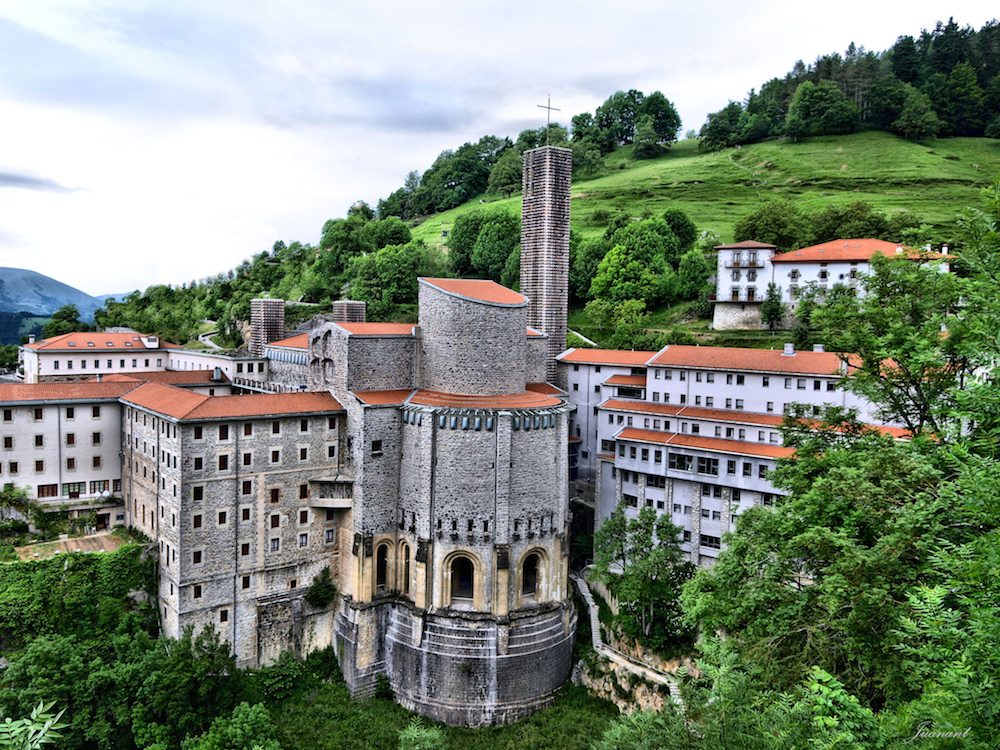This article was translated by John R. Bopp
We’ve recently come across a desktop background image that offers us an amazing perspective of the incredibly beautiful Sanctuary of Our Lady of Arantzazu. It’s a photo of a magical and extraordinary place in the Land of the Basques, and we wanted to share it with our readers.
It also brought to mind an anecdote about the legend that explains the construction of a sanctuary there in the second half of the 16th century. It’s an anecdote wherein an expression in Basque is translated as a long paragraph into Spanish. This translation has always brought a smile to our face, and we hope our readers will also like it.
We’ll leave you with the photo so you can download it in high resolution, and the anecdote itself, using the text from the Wikipedia article (the anecdote is in bold).
Wallpaperup

Original, high-resolution photo
—————–
Etymology of the Name of the Sanctuary – – Wikipedia
The name of the sanctuary, the place, and the Virgin are all related to the legend of her appearance. The word arantzazu itself is made up of “arantza” which means “thorn”[1] and the suffix “zu” indicating “abundance”[2], making the translation “abundance of thorns”, making reference to the abundant thorny bushes that grow in the area.
Esteban de Garibay, in his Compendio historial de las Chrónicas y universal historia de todos los Reynos d’España (1571),[3] states that the Virgin appeared to a young girl named María de Datuxtegui. In the same book, however, he gives another version, which is better known. Garibay says that he heard this story from the mouth of a witness who knew a shepherd named Rodrigo de Balzategui. This man had said he found a small image of the Virgin with a child in her arms, hidden in a thorny bush, next to a cowbell. Upon seeing it, he exclaimed, Arantzan zu?!, meaning “In the thorns, you?!”.
This legend again appears in the first history of the sanctuary written by Franciscan Gaspar de Gamarra, twenty years later in 1648:
Llámasse Aránzazu en buen lenguaje cántabro-bascongado y como la ethimología de haverse hallado esta santa imagen en un espino, que en esta lengua se llama Aranza y se le añade la dicción zu, y es a mi ver lo que sucedió en el misterioso hallazgo de esta soberana margarita que, lleno de admiraciones el pastor, viendo una imagen tan hermosa y resplandeciente de María Santíssima que hacía trono de un espino, la dijo con afectos del corazón: Arantzan zu?, que es como si dixera en lengua castellana: Vos, Señora, siendo Reyna de los Angeles, Madre de Dios, abogada de pecadores, refugio de afligidos, y a quien se deven tantas veneraciones y adoraciones, cuando merecíais estar como estáis en los cielos en throno de Seraphines, mucho más costoso y vistoso que el que hizo Salomón para su descanso. Vos, Señora, en un espino?
It is called Aránzazu in good Cantabrian-Basque language and its etymology comes from that holy image in a thorn bush, which in this language is called Aranza to which the word zu is added, and it is my understanding that what happened in the mysterious finding of this sovereign daisy who, when the shepherd was full of admiration watching such a beautiful and shiny image of the Most Holy Mary on a throne in a thorn bush, told her with affection in his heart: Arantzan zu?, which is as if he were saying in Spanish: You, My Lady, being the Queen of the Angels, Mother of God, advocate for the sinners, refuge for the distraught, to whom so much veneration and adoration is owed, when you deserve to be as you are in heaven, on a throne of Seraphim, much more costly and attractive than the one Solomon made for his rest. You, My Lady, in a thorn bush?
Historian Padre Lizarralde, who created the sanctuary’s coat of arms, based its design on the legend, and drew a thorn bush, out of which a star blooms, and with its light it scares away the dragon, sending it into the abyss. The legend reads “Arantzan zu”.
(Sigue) (Automatic translation)
Last Updated on Dec 20, 2020 by About Basque Country




























